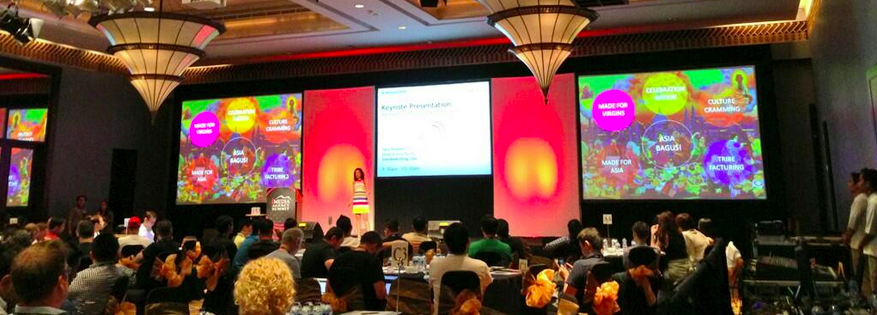iMedia Agency Summit: Day Two
Following the roundtables at the start of day two, the first full day of the iMedia Agency Summit in Bali got underway with a keynote session from Tara Hirebet of Trendwatching.
Tara took us on a whirlwind journey Asian culture, sharing an incredible wealth of insights in her half-hour slot:
Made For Asia
Asian Consumers want the best of the West and the East. International quality and status but adapted to fit into their national and even regional culture, lifestyle and habits. This translates into a variety of Asia-specific products, with some brands (including Starbucks) even developing offerings specific to individual Asian cities.
Made For Virgins
Asian consumers are more likely to try new products that are made familiar to, similar to or connect to their current cultural habits or lifestyle, than risk trying one they don’t understand. This can be about tweaking flavours to appeal to Asian tastes, creating new consumption rituals around existing products to appeal to Asian lifestyles and cultures, or simply finding ways to tie your brand to the local context.
Celebration NationAsians are looking for ways to celebrate their success as cultural and economic powerhouses through products that express, update, reinvent and allow them to flaunt their rich and diverse cultures. Many homegrown Asian brands are finding success by harnessing cultural heritage, from high fashion inspired by myths and legends to contemporary fashion that blends traditional ethnic styles, and from luxury version of traditional food and drink products, to more risqué foodstuffs that offer a tongue-in-cheek tweak on well-known nibbles.
Culture CrammingAsians will snap up devices, apps, interactive sites and games that allow them to celebrate their culture, cuisines, customs, festivals and faith, online and on the go. Asians are increasingly time-poor, and people want to maximise every minute, so they’re embracing whatever helps them do that. Similarly, Asians spend a huge amount of time in queues and in traffic, so brands that can help them make better use of this time are in high demand
Traffic is an issue throughout Asia. Image c/o Trendwatching.
Culture cramming relates to a variety of different activities, whether it’s entertainment on the go (e.g. Changba’s ‘karaoke-meets-Instagram’ app), celebrating festivals (e.g. Alipay’s QR-based e-hóngbāo), finding socially endorsed food experiences (e.g. Burpple), or adding a mobile element to faith (e.g. Lac Hong Vien Cemetery’s online “afterlife gift” purchase).
Very Important TravellersAsian travel tribes often have their own specific cultural or faith-based needs that will heavily determine the places they travel to, stay in, eat in and even shop in. Brands that cater to travelling Asians can reap special rewards, whether it’s by offering tailored shopping experiences, catering to Asian dietary preferences, or creating guidebooks that cater to Asian needs.
Tribe-FacturingImmigrants: The Asian diaspora number in the millions and are in need of offerings that either are a fusion of East and West like they are themselves, or connect them to their families and home countries via products or services.Family Values: Asian families need ways to manage multigenerational lifestyles as well as stay connected through busy diverse schedules and even living apart.Minisumers: Help parents get their kids a head start in life, and prepare them for a competitive and tough future amongst the billions.
Other Highlights From Day 2
The remainder of Day 2 focused on specific company profiles, but here’s a selection of some of the richer insights and soundbites:
Goodstuph‘s Pat Law noted that one of the biggest challenges marketers face in social media is that they don’t own the data about the audiences they build. As a result, they’re effectively ‘held hostage’ by the platforms’ business model. Pat went on to stress that real social media isn’t about buying or earning media space; it’s about driving meaningful talkability. As a result, brands need to rethink their KPIs – for example, turning a complaint into a thank you.
TubeMogul‘s Phu Truong noted that the average media plan takes 77 hours to prepare, but went on to say that TubeMogul’s research showed 75 of these hours are dedicated to process management rather than adding new value. Marketers need to find and use the tools that help them streamline these processes, and focus more of their time on added-value activities that will deliver increased ROI.
Stanley Lim from Innity Corp stressed that brands need to think of digital in terms of brand uplift as well as sales; we need to measure consideration and favorability / intent as well as conversion. We need to think what happens post sale too – how can digital help to keep the relationship alive? Stanley suggested social media has a vital role to play here, but added a caveat in the form of a quote from Barack Obama: “Don’t run a social campaign; make all your campaigns social.” He went on to note that “real engagement is dynamic, so measurement needs to be about more than views, clicks and actions.“
Stuart Spiteri of Brandscreen continued this theme, observing that “as an industry, we’re fixated on CPM [cost per thousand impressions], but the driver of value is engagement, not price.” He followed up with the insight that far too much of our planning revolves around budgeting cycles rather than audiences needs and behaviour – something he strongly believes needs to change.
Tim Holland of Perform Group shared a host of useful stats about sports and social media, starting with the fact that second screening is very high in Asia. According to his company’s research, 21% of people watching sports on TV in China do so with the help of a second screen (e.g. mobile or tablet), while the figure is 19% in Indonesia. Tim also stressed that sports fans are usually very passionate, and engage with their teams and favourite players across a variety of channels, so brands need to find ways to add distinct value across the ecosystem.
Top image c/o @chrissbell on Instagram.

